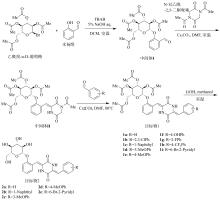| [1] |
汤勇, 廖升荣, 李晋昇, 等, 2016. 含氟2, 5-二酮哌嗪衍生物的设计、合成及细胞毒活性[J]. 中国药科大学学报, 47(4): 412-421.
|
|
TANG YONG, LIAO SHENGRONG, LI JINSHENG, et al, 2016. Design, synthesis and cytotoxic activities of fluorine-containing 2, 5-diketopiperazine derivatives[J]. Journal of China Pharmaceutical University, 47(4): 412-421. (in Chinese with English abstract)
|
| [2] |
BLAYNEY D W, LELORIER Y, MITCHELL D, et al, 2022. Combination plinabulin plus pegfilgrastim (Plin plus Peg) had better toxicity management and health related quality-of-life (HrQoL) compared to Peg alone in early-stage breast cancer (BC) patients (pts) treated with taxotere, doxorubicin and cyclophosphamide (TAC)[J]. Cancer Research, 82(4): Supplement.
|
| [3] |
BORTHWICK A D, 2012. 2, 5-Diketopiperazines: synthesis, reactions, medicinal chemistry, and bioactive natural products[J]. Chemical Review, 112(7): 3641-3716.
doi: 10.1021/cr200398y
|
| [4] |
BRYANS J, CHARLTON P, CHICARELLI-ROBINSON I, et al, 1996. Inhibition of plasminogen activator inhibitor-1 activity by two diketopiperazines, XR330 and XR334 produced by Streptomyces sp.[J]. The Journal of Antibiotics, 49(10): 1014-1021.
doi: 10.7164/antibiotics.49.1014
|
| [5] |
CHEN SANGLUO, ZHANG DI, CHEN MENGXUAN, et al, 2020. A rare diketopiperazine glycoside from marine-sourced Streptomyces sp. ZZ446[J]. Natural Product Research, 34(7): 1046-1050.
doi: 10.1080/14786419.2018.1544978
|
| [6] |
CHINH P T, THAM P T, QUYNH D H, et al, 2021. Synthesis and cytotoxic activity of several novel N-alkyl-plinabulin derivatives with aryl group moieties[J]. Natural Product Communications, 16(4): 1-6.
|
| [7] |
DALE I L, TUFFLEY W, CALLAGHAN R, et al, 1998. Reversal of P-glycoprotein-mediated multidrug resistance by XR9051, a novel diketopiperazine derivative[J]. British Journal of Cancer, 78(7): 885-892.
pmid: 9764579
|
| [8] |
HUANG RIMING, YI XIANGXI, ZHOU YUYING, et al, 2014. An update on 2, 5-diketopiperazines from marine organisms[J]. Marine Drugs, 12(12): 6213-6235.
doi: 10.3390/md12126213
|
| [9] |
KAMEI H, OKA M, HAMAGISHI Y, et al, 1990. Piperafizines a and b, potentiators of cytotoxicity of vincristine[J]. The Journal of antibiotics, 43(8): 1018-1020.
doi: 10.7164/antibiotics.43.1018
|
| [10] |
KANOH K, KOHNO S, ASARI T, et al, 1997. (-)-Phenylahistin: a new mammalian cell cycle inhibitor produced by Aspergillus ustus[J]. Bioorganic Medicinal Chemistry Letter, 7(22): 2847-2852.
|
| [11] |
LIAO SHENGRONG, QIN XIAOCHU, LI DING, et al, 2014. Design and synthesis of novel soluble 2, 5-diketopiperazine derivatives as potential anticancer agents[J]. European Journal of Medicinal Chemistry, 83: 236-244.
doi: 10.1016/j.ejmech.2014.06.030
|
| [12] |
LIAO SHENGRONG, XU YING, TANG YONG, et al, 2015. Design, synthesis and biological evaluation of soluble 2, 5-diketopiperazines derivatives as potential antifouling agents[J]. Rsc Advances, 5(63): 51020-51026.
doi: 10.1039/C5RA06210A
|
| [13] |
LIAO SHENGRONG, DU LIJUAN, QIN XIAOCHU, et al, 2016a. Site selective synthesis of cytotoxic 1, 3, 6-trisubstituted 3, 6-diunsaturated (3Z, 6Z)-2, 5-diketopiperazines via a one-pot multicomponent method[J]. Tetrahedron, 72(8): 1051-1057.
doi: 10.1016/j.tet.2015.12.073
|
| [14] |
LIAO SHENGRONG, QIN XIAOCHU, WANG ZHEN, et al, 2016b. Design, synthesis and cytotoxic activities of novel 2, 5-diketopiperazine derivatives[J]. European Journal of Medicinal Chemistry, 121: 500-509.
doi: 10.1016/j.ejmech.2016.06.002
|
| [15] |
LIPINSKI C A, 2000. Drug-like properties and the causes of poor solubility and poor permeability[J]. Journal of Pharmacological and Toxicological Methods, 44(1): 235-249.
doi: 10.1016/s1056-8719(00)00107-6
pmid: 11274893
|
| [16] |
LOUGHLIN W A, MARSHALL R L, CARREIRO A, et al, 2000. Solution-phase combinatorial synthesis and evaluation of piperazine-2, 5-dione derivatives[J]. Bioorganic & Medicinal Chemistry Letter, 10(2): 91-94.
|
| [17] |
MATULJA D, WITTINE K, MALATESTI N, et al, 2020. Marine natural products with high anticancer activities[J]. Current Medicinal Chemistry, 27(8): 1243-1307.
doi: 10.2174/0929867327666200113154115
|
| [18] |
MONDAL A, BOSE S, BANERJEE S, et al, 2020. Marine cyanobacteria and microalgae metabolites-a rich source of potential anticancer drugs[J]. Marine Drugs, 18(9): 476-535.
doi: 10.3390/md18090476
|
| [19] |
MOTA F L, CARNEIRO A R, QUEIMADA A J, et al, 2009. Temperature and solvent effects in the solubility of some pharmaceutical compounds: measurements and modeling[J]. European Journal of Pharmaceutical Sciences, 37(3-4): 499-507.
doi: 10.1016/j.ejps.2009.04.009
pmid: 19406228
|
| [20] |
NADAR V M, MANIVANNAN S, CHINNAIYAN R, et al, 2022. Review on marine sponge alkaloid, aaptamine: A potential antibacterial and anticancer drug[J]. Chemical Biology & Drug Design, 99(1): 103-110.
|
| [21] |
POPOVIĆ-DJORDJEVIĆ J, QUISPE C, GIORDO R, et al, 2022. Natural products and synthetic analogues against HIV: A perspective to develop new potential anti-HIV drugs[J]. European Journal of Medicinal Chemistry, 233: 114217-114242.
doi: 10.1016/j.ejmech.2022.114217
|
| [22] |
RYCEK L, 2022. Total synthesis of natural products: case studies in the evaluation of new synthetic methods, structural elucidation and drug discovery[J]. Chemistry Listy, 116(4): 204-214.
doi: 10.54779/chl20220204
|
| [23] |
SINGH A V, BANDI M, RAJE N, et al, 2011. A novel vascular disrupting agent plinabulin triggers JNK-mediated apoptosis and inhibits angiogenesis in multiple myeloma cells[J]. Blood, 117(21): 5692-5700.
doi: 10.1182/blood-2010-12-323857
pmid: 21454451
|
| [24] |
SONG ZHIQIANG, HOU YAGE, YANG QINRONG, et al, 2021. Structures and biological activities of diketopiperazines from marine organisms: A review[J]. Marine Drugs, 19(8): 403-438.
doi: 10.3390/md19080403
|
| [25] |
THAM P T, CHINH P T, TUYEN N V, et al, 2021. Synthesis and cytotoxic evaluation of novel simplified plinabulin-quinoline derivatives[J]. Mendeleev Communications, 31(2): 213-215.
doi: 10.1016/j.mencom.2021.03.022
|
| [26] |
VAN DE WATERBEEMD H, SMITH D A, BEAUMONT K, et al, 2001. Property-based design: Optimization of drug absorption and pharmacokinetics[J]. The Journal of Medicinal Chemistry, 44(9): 1313-1333.
doi: 10.1021/jm000407e
|
| [27] |
WANG SHUMING, GOLEC J, MILLER W, et al, 2002. Novel inhibitors of plasminogen activator inhibitor-1: Development of new templates from diketopiperazines[J]. Bioorganic & Medicinal Chemistry Letter, 12(17): 2367-2370.
|
| [28] |
YAMAZAKI Y, TANAKA K, NICHOLSON B, et al, 2012, Synthesis and structure-activity relationship study of antimicrotubule agents phenylahistin derivatives with a aidehydropiperazine-2, 5-dione Structure[J], The Journal of Medicinal Chemistry, 55(3): 1056-1071.
doi: 10.1021/jm2009088
|
 ), XU Huayan3, LI Xiaolin1,2, LIU Yonghong1,2,3(
), XU Huayan3, LI Xiaolin1,2, LIU Yonghong1,2,3( )
)











